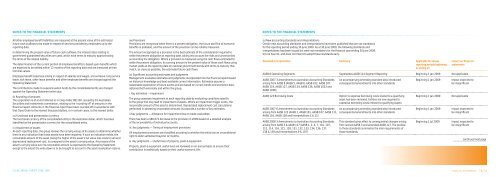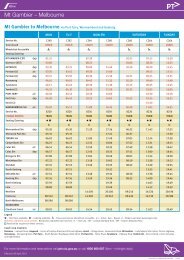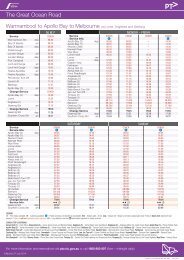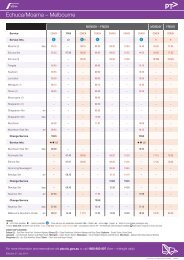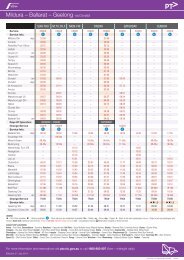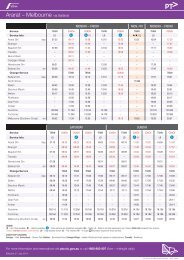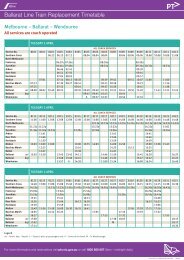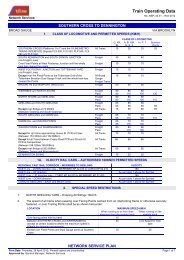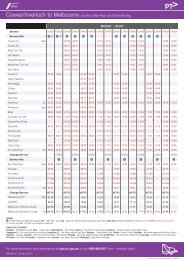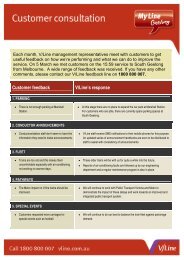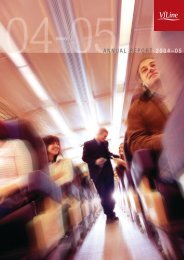annual report 2008-2009 - V/Line
annual report 2008-2009 - V/Line
annual report 2008-2009 - V/Line
Create successful ePaper yourself
Turn your PDF publications into a flip-book with our unique Google optimized e-Paper software.
NOTES TO THE FINANCIAL STATEMENTS<br />
NOTES TO THE FINANCIAL STATEMENTS<br />
All other employee benefit liabilities are measured at the present value of the estimated<br />
future cash outflows to be made in respect of services provided by employees up to the<br />
<strong>report</strong>ing date.<br />
In determining the present value of future cash outflows, the interest rates relating to<br />
government guaranteed securities are used, which have terms to maturity approximating<br />
the terms of the related liability.<br />
The determination of the current portion of employee benefits is based upon benefits which<br />
are expected to be settled within 12 months of the <strong>report</strong>ing date and are measured at their<br />
nominal values.<br />
Employee benefit expenses arising in respect of salaries and wages, <strong>annual</strong> leave, long service<br />
leave, sick leave, other leave benefits and other employee benefits are charged against the<br />
Operating Statement.<br />
The contributions made to superannuation funds by the consolidated entity are charged<br />
against the Operating Statement when due.<br />
(t) Rounding of amounts<br />
The corporation is of a kind referred to in Class Order 98/100, issued by the Australian<br />
Securities and Investments commission, relating to the ‘rounding off’ of amounts in the<br />
financial <strong>report</strong>. Amounts in the financial <strong>report</strong> have been rounded off in accordance with<br />
that Class Order to the nearest thousand dollars, or in certain cases, to the nearest dollar.<br />
(u) Functional and presentation currency<br />
The functional currency of the consolidated entity is the Australian dollar, which has been<br />
identified as the presentation currency for the consolidated entity.<br />
(v) Impairment of assets<br />
At each <strong>report</strong>ing date, the group reviews the carrying values of its assets to determine whether<br />
there is any indication that those assets have been impaired. If such an indication exists, the<br />
recoverable amount of the asset, being the higher of the asset’s fair value less costs to sell and<br />
depreciated replacement cost, is compared to the asset’s carrying value. Any excess of the<br />
asset’s carrying value over its recoverable amount is expensed to the Operating Statement,<br />
except to the extent the write-down is to be brought to account in the asset revaluation reserve.<br />
(w) Provisions<br />
Provisions are recognised when there is a present obligation, the future sacrifice of economic<br />
benefits is probable, and the amount of the provision can be reliably measured.<br />
The amount recognised as a provision is the best estimate of the consideration required to<br />
settle the present obligation at <strong>report</strong>ing date, taking into account the risks and uncertainties<br />
surrounding the obligation. Where a provision is measured using the cash flows estimated to<br />
settle the present obligation, its carrying amount is the present value of those cash flows using<br />
market yields at the <strong>report</strong>ing date on national government bonds with terms to maturity that<br />
match, as close as possible, the estimated future cash flows.<br />
(x) Significant accounting estimates and judgments<br />
Management evaluates estimates and judgments incorporated into the financial <strong>report</strong> based<br />
on historical knowledge and best available current information. Estimates assume a<br />
reasonable expectation of future events and are based on current trends and economic data,<br />
obtained both externally and within the group.<br />
i. Key estimates — Impairment<br />
The group assesses impairment at each <strong>report</strong>ing date by evaluating conditions specific<br />
to the group that may lead to impairment of assets. Where an impairment trigger exists, the<br />
recoverable amount of the asset is determined. Depreciated replacement cost calculations<br />
performed in assessing recoverable amounts incorporate a number of key estimates.<br />
ii.Key judgments — Allowance for impairment loss on trade receivables<br />
There has been a $80,072 decrease to the provision in <strong>2009</strong> based on a detailed analysis<br />
of the recoverability of individual accounts.<br />
iii. Key judgments — Timing of employment provisions<br />
All employment provisions are classified according to whether the entity has an unconditional<br />
right to defer settlement beyond 12 months.<br />
iv. Key judgments — Useful lives of property, plant & equipment<br />
Property, plant & equipment useful lives are reviewed on an <strong>annual</strong> basis to ensure their<br />
contribution is realistically based on their useful economic life.<br />
(y) New accounting standards and interpretations<br />
Certain new accounting standards and interpretations have been published that are not mandatory<br />
for the <strong>report</strong>ing period ending 30 June <strong>2009</strong>. As at 30 June <strong>2009</strong>, the following standards and<br />
interpretations had been issued but were not mandatory for the financial year ending 30 June <strong>2009</strong>.<br />
V/<strong>Line</strong> has not, and does not intend to adopt these standards early.<br />
Standard/Interpretation Summary Applicable for <strong>annual</strong><br />
<strong>report</strong>ing periods beginning<br />
or ending on<br />
Impact on financial<br />
statements<br />
AASB 8 Operating Segments Supersedes AASB 114 Segment Reporting Beginning 1 Jan <strong>2009</strong> Not applicable<br />
AASB 2007-3 Amendments to Australian Accounting Standards<br />
arising from AASB 8 [AASB 5, AASB 6, AASB 102, AASB 107,<br />
AASB 119, AASB 127, AASB 134, AASB 136, AASB 1023 and<br />
AASB 1038]<br />
AASB 123 Borrowing Costs<br />
AASB 2007-6 Amendments to Australian Accounting Standards<br />
arising from AASB 123 [AASB 1, AASB 101, AASB 107, AASB 111,<br />
AASB 116, AASB 138 and Interpretations 1 & 12]<br />
AASB <strong>2008</strong>-3 Amendments to Australian Accounting Standards<br />
arising from AASB 3 & AASB 127 [AASB 1, 2, 4, 7, 101, 107,<br />
112, 114, 116, 121, 128, 131, 132, 133, 134, 136, 137,<br />
138 & 139 and Interpretations 9 & 107]<br />
An accompanying amending standard also introduced<br />
consequential amendments into other standards<br />
Option to expense borrowing costs related to a qualifying<br />
asset has been removed. Entities are now required to<br />
capitalise borrowing costs relevant to qualifying assets<br />
An accompanying amending standard also introduced<br />
consequential amendments into other standards<br />
This standard gives effect to consequential changes arising<br />
from revised AASB 3 and amended AASB 127. The preface<br />
to those standards summarise the main requirements of<br />
those standards<br />
Beginning 1 Jan <strong>2009</strong><br />
Beginning 1 Jan <strong>2009</strong><br />
Beginning 1 Jan <strong>2009</strong><br />
Beginning 1 Jul <strong>2009</strong><br />
Impact expected to<br />
be insignificant<br />
Not applicable<br />
Impact expected to<br />
be insignificant<br />
Impact expected to<br />
be insignificant<br />
continued next page<br />
V/LINE ANNUAL REPORT <strong>2008</strong>-<strong>2009</strong> FINANCIAL STATEMENTS 78/79


